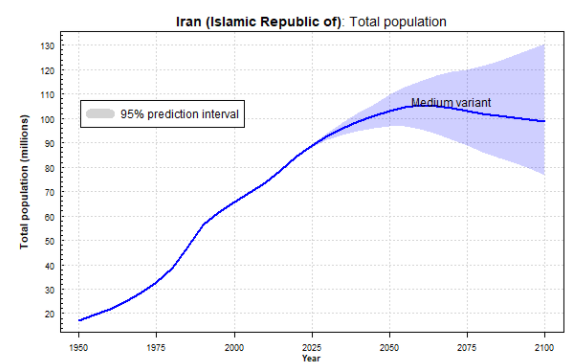September 3, 2021

The population is now about 84 million and Supreme Leader Ali Khamenehi wants it to rise to 150 million, saying that will make Iran a more powerful country. Others, however, question whether Iran can sustain that many people given how bad its water supply has already become.
The UN projection, seen in the chart at right, shows the most likely outcome is for the population to reach about 105 million in the early 2060s and then begin a slow decline, with the population at around 100 million in 2100. (There are two more charts on Page 15.)
That assumes that birthrates continue to be low. The birth rate now is at or just below the rate needed to replace those alive today. But since there are so many people still of age to become parents, the population is still growing.
The UN chart shows that if the birthrate slumps more, the population could start to decline in the early 2050s. On the other hand, if the regime’s efforts to promote childbirth begin to work—which they have not in the past decade—then the population could still be growing in 2100, when it would pass 130 million.
The fertility rate—or the number of children the average woman gives birth to—was estimated at 6.5 in 1983 by the UN, as seen in a chart on Page 15. It then began a precipitous decline, falling to 1.8 in 2008. For the population to remain steady over time, the fertility rate needs to be 2.1.
It is estimated by the UN that the fertility rate has now recovered to 2.1. But few expect it to remain there. The UN projects the fertility rate will have fallen to about 1.7 in the 2060s, and that is the basis for its projection that Iran’s total population will begin to fall then.
Melinda Gates, the co-founder of the Bill & Melinda Gates Foundation, wrote, “The fastest decrease in the rate of childbearing per woman in the history of the world has happened in Iran!”
To counter that, 14 policies to support childbearing and the family were announced by the Supreme Leader in 2014.
The Majlis approved a new program in March to implement a population growth and family support plan for seven years in an effort to boost the fertility rate.
